December 6th, 2017 by iisg_superadmin
Environmental DNA, or eDNA, had a moment in the limelight around 2010, when through the use of this monitoring tool, researchers found evidence of Asian carp in Chicago waterways past the electric barrier installed to stop these fish, and within range of Lake Michigan.
This news, along with several captures of Asian carp in local waters, alerted resource managers and other decision makers to the status of these fish that pose a threat to the Great Lakes.
Environmental DNA is detected in traces of shed skin, hair, mucus and waste, for example, that an organism leaves behind in its surroundings. This monitoring tool was initially used to survey microorganism biodiversity and to sample ancient DNA in soil or ice cores. In the past decade or more, eDNA sampling has been used in lakes and rivers to check for the presence or absence of a species as well as quantifying how many species are found in the waterway.
“Through the newest method, eDNA metabarcoding, we can identify the presence of all fish species inhabiting a body of water,” said Nathan Evans, a postdoc at Florida International University. With Illinois-Indiana Sea Grant funding, Evans, while a graduate student at the University of Notre Dame, assessed the effectiveness of eDNA for conservation management through a literature review of related studies.
He found that eDNA sampling has some advantages over traditional sampling, which include netting fish, electrofishing, or doing visual surveys. These methods are effort intensive and typically have low detection probabilities for rare species, meaning that there is a smaller chance that these less abundant species will show up in sampling.
“Whether in fish or bird or mammal communities, the typical pattern is that they are comprised of a few very abundant species, and large numbers of rare species,” he explained. “Using eDNA increases detection probabilities for those rare species.”
But eDNA sampling is not a replacement for traditional monitoring methods. “With traditional sampling, you are holding the fish, you can measure many more aspects, including size and sex,” said Evans. “With eDNA, you are learning if the fish is there or not, and possibly its abundance.”
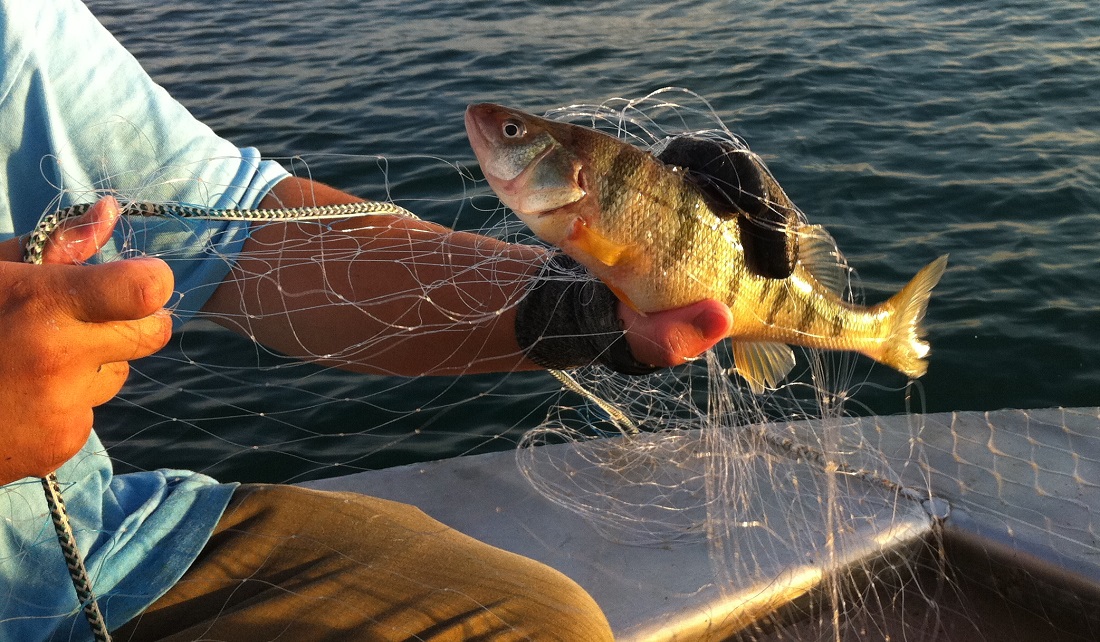
Through traditional sampling, researchers can gather information about the status of yellow perch in Great Lakes waters.
As part of Gary Lamberti’s lab at Notre Dame, Evans also engaged in field research on the costs and effectiveness of using eDNA to sample water bodies. Currently, eDNA is more costly than traditional sampling, but is more effort efficient—it provides a more thorough sample of a system with less effort.
Going forward, he sees eDNA costs coming down and the process getting faster, potentially providing the technology to have immediate information in the field. And, research related to eDNA transport is growing. “Right now we sample downstream to learn about fish that are upstream. But we don’t know how far upstream they are—it could be two feet or 20 miles,” Evans said. “The technology will advance to enable us to pinpoint where species are in a watershed. This will revolutionize species management and ecological research.”
This literature review is published in the January 2018 issue of Fisheries Research.
November 30th, 2017 by iisg_superadmin
In the past few months, Illinois-Indiana Sea Grant (IISG) educators rocked out with new partners to raise awareness about the threat of Asian carp. Jumpin’ Jack, IISG’s costumed silver carp sensation, was on tour at several large public venues in Milwaukee, and Education Coordinator Terri Hallesy made an appearance at Water Palooza in Chicago.
Jumpin’ Jack’s stops in Milwaukee were part of IISG’s new partnership with the Great Lakes Community Conservation Corp (Great Lakes CCC). This group is focused on training and educating disadvantaged populations in the Greater Milwaukee region, including about environmental issues. The group introduced the bedazzled Jumpin’ Jack at a tailgate party before a Brewers-Cubs game and at the Milwaukee Harbor Festival.
At both events, the Great Lakes CCC brought visitors to their booth through the costumed character as well as with cuisine, demonstrating the value of cooking these fishes. Asian carp sliders were on the menu at the tailgate party and tacos at the harbor festival.
“We ran out well before the event was over, serving 350 Asian carp tacos,” said Chris Litzau, Great Lakes CCC president. While tacos were served, Jumpin Jack posed for photos and danced for the crowd.
Visitors to the booth also learned about the threat and impact of aquatic invasive species to Great Lakes and other waters. Asian carp are prevalent in the Illinois River, with an electric barrier in the Chicago Sanitary and Ship Canal deterring them from entering Lake Michigan. Researchers and resource managers are concerned that these large fish could have devastating impact on the Great Lakes food chain.
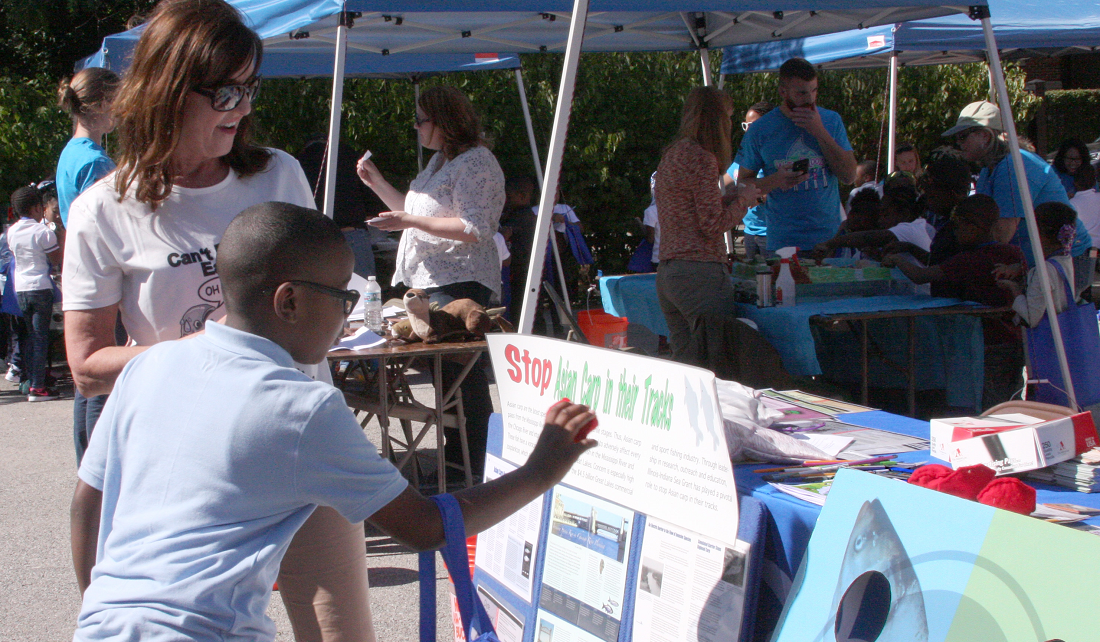
IISG Education Coordinator Terri Hallesy helps a Manierre Elementary School student stop Asian carp in their tracks.
Like its more-crowded namesake, Water Palooza is an outdoor event geared towards young people—but in this case, elementary school children. This one-day event is organized by the Water Environment Federation’s Student and Young Professionals Committee. This year it was held on September 29 at Manierre Elementary School in Chicago.

Free pencils at Water Palooza help make it a great day.
At Water Palooza, students take part in hands‐on activities that help them learn the value of water and encourage them to care about water in their world. This year, IISG joined in the festivities with a stuffed animal Asian carp, a Stop the Carp in Their Tracks beanbag tossing game, and other aquatic invasive species-related activities.
“By engaging students in interactive activities, they develop knowledge about aquatic invasive species issues and how they pose a threat to our water resources,” said Hallesy. “Water Palooza provides students with an opportunity to develop awareness, understanding, and a stewardship ethic about an important environmental issue, and learn how we can work together as agents for change.”
Illinois-Indiana Sea Grant is a part of University of Illinois Extension and Purdue University Extension.
November 6th, 2017 by iisg_superadmin
Much needed attention has been directed at some particularly problematic aquatic invasive species in the Great Lakes, such as Asian carps and zebra and quagga mussels. But others invaders, like crayfish, can also take their toll on the lakes.
Illinois-Indiana Sea Grant (IISG) has created a new collaborative that brings together a variety of experts and stakeholders to address the threat of invasive crayfish. The Invasive Crayfish Collaborative (ICC), includes 68 experts and other stakeholders from government agencies, universities, non-profit organizations, and private businesses to combine resources and expertise to address priority invasive crayfish research and outreach needs.
Rusty crayfish, native to the Ohio River basin, are already in all Great Lakes states. These invaders can dramatically alter food webs in aquatic environments, first reducing populations of slow moving invertebrates, like snails, and then, when that food source is gone, turning to plants. The crayfish’s consumption of aquatic vegetation can lead to a total loss of rooted plants in the water, which, in turn, can contribute to changes in fish populations.
Other non-native crayfish species also pose a threat to the region, including the red swamp crayfish—listed as one of the 100 worst invasive species in the world, the Australian red claw, and another Australian species, yabby crayfish, which have the ominous scientific name of Cherax destructor.
“Techniques for managing invasive crayfish are largely lacking. Because of this, current efforts to prevent their introduction and spread are mostly aimed at anglers and pet owners—encouraging them to refrain from releasing crayfish into new bodies of water,” said Pat Charlebois, IISG aquatic invasive outreach coordinator.
Funding for research on invasive crayfish management is also limited, so ICC is identifying priority invasive crayfish research needs. U.S. EPA has funded IISG through the Great Lakes Restoration Initiative to establish the new collaborative for the Great Lakes region.
“We know that preventing the arrival of new invasive species, and controlling the spread and impacts of those already here, requires everything from basic research to policy and outreach,” said Reuben Keller of the Institute of Environmental Sustainability at Loyola University Chicago, who is funded through this project to identify species of concern for the Great Lakes. “This collaborative will bring together experts and stakeholders so that the risk of invasive crayfish in the Great Lakes can be better understood and managed, and we encourage all stakeholders to get involved.”
The work of the collaborative will include prioritizing research and outreach needs, identifying crayfish of particular concern, developing a framework for evaluating management techniques, and creating communication tools for ICC members, including a website.
October 17th, 2017 by iisg_superadmin
Illinois-Indiana Sea Grant (IISG) plans to award $675,000 to four new research projects that will help inform decision makers as they address some of the region’s pressing environmental issues, including managing stormwater, restoring stream habitats and protecting beachfronts. The research will take place in 2018-2019.
Two projects will focus on green infrastructure as part of stormwater management, but using different approaches. At the University of Illinois, landscape architect Mary Pat McGuire will lead a diverse team that includes David Grimley with the Illinois State Geological Survey (ISGS) to create a soils database for the Calumet region southeast of Chicago to assess soil health and appropriateness for effective green infrastructure. The researchers will evaluate green infrastructure planning in the region and work with municipalities in pilot projects to help integrate their findings into site selection and design strategy decisions.
Bernie Engel and colleagues in the Purdue University Department of Agricultural and Biological Engineering will enhance their simulation software to include the long-term effects of green infrastructure on reducing and preventing flooding. Their model is part of the Tipping Point Planner online toolbox, which helps local decision makers plan for future development in their communities. This new project will be closely tied to a south side Chicago neighborhood—Washington Park. There, using their updated model, the research team hopes to demonstrate the impact of optimally-places green infrastructure on flooding. Akilah Martin, in DePaul University’s School for New Learning, will help share these results with students and local residents.

Washington Park, Chicago, Illinois
At the University of Illinois, hydrogeologist Piotr Cienciala and ecological physiologist Cory Suski will lead a multi-disciplinary project to study the effect of turbulence on fish swimming behavior. By studying how the physiology of various fish species is affected by water movement, the researchers can help inform the placement of fish passage structures as part of stream restoration projects. The findings will likely be transferable to stream projects beyond the Great Lakes region and may help inform simulations to explore restoration outcomes under various projected climate or land use change scenarios that alter water movement and fish habitat.
U of I researchers will also use historical documents of the geology of the Illinois shoreline to help beach managers predict and address future conditions. Through old photos and reports, ISGS’s Ethan Theuerkauf will lead an effort to tell the story of land changes and environmental conditions over the last century at Illinois Beach State Park. Experts from the Prairie Research Institute, Midwest Regional Climate Center, and Great Lakes Integrated Sciences and Assessment Center are also taking part in this research. Working closely with beach managers, the researchers will develop future coastal change scenarios to help inform the decision making process.
“Illinois-Indiana Sea Grant is excited to support these new research efforts,” said Tomas Hook, IISG associate director for research. “They are targeting issues that have been identified as priorities for the Lake Michigan region of Illinois and Indiana and they have great potential to yield solution-based results for our region. Collectively, these projects should also contribute to informing infrastructure and environmental management in coastal regions throughout the United States.”
Illinois-Indiana Sea Grant is a part of University of Illinois Extension and Purdue University Extension.
August 8th, 2017 by iisg_superadmin
Illinois-Indiana Sea Grant’s Terri Hallesy and Leslie Dorworth and I pulled up along the river’s edge and parked our car on the gravel road. As our group approached the bank, two majestic egrets took flight looking like purest snow against a backdrop of vibrant blues and green. A bald eagle had been spotted earlier, perched on a favorite branch of a dead cottonwood hanging over the river.
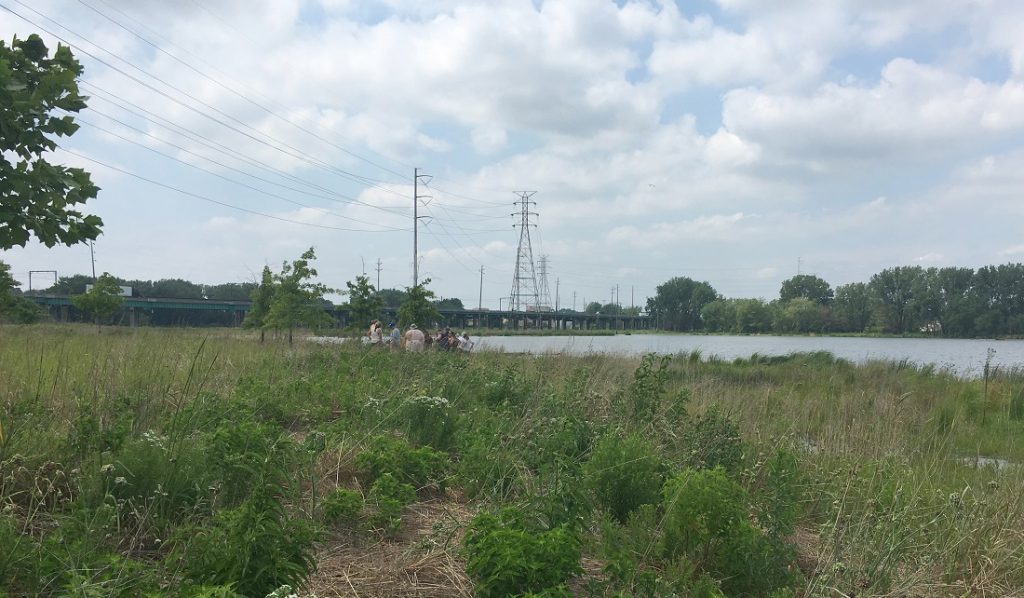
Educators tour Roxana Marsh, a 19-acre restoration site.
It’s hard to believe that five years ago, a brown stand of the invasive species, Phragmites, had dominated the landscape where we were standing. The Grand Calumet River has made a radical transformation over the last 10 years thanks to the Great Lakes Legacy Act and many dedicated federal, state, and local partners. Our mission that day was to help 42 teachers from South Bend, Indiana understand just how large the ongoing transformation is, in hopes that they would carry this inspirational message back to their classrooms in the form of science labs, writing assignments, and other educational activities.
We set out to accomplish this mission by hosting an IISG teacher workshop at Purdue University Northwest, Hammond campus in collaboration with The Nature Conservancy (TNC), the Indiana Department of Natural Resources (DNR), and the Indiana Department of Environmental Management (IDEM).
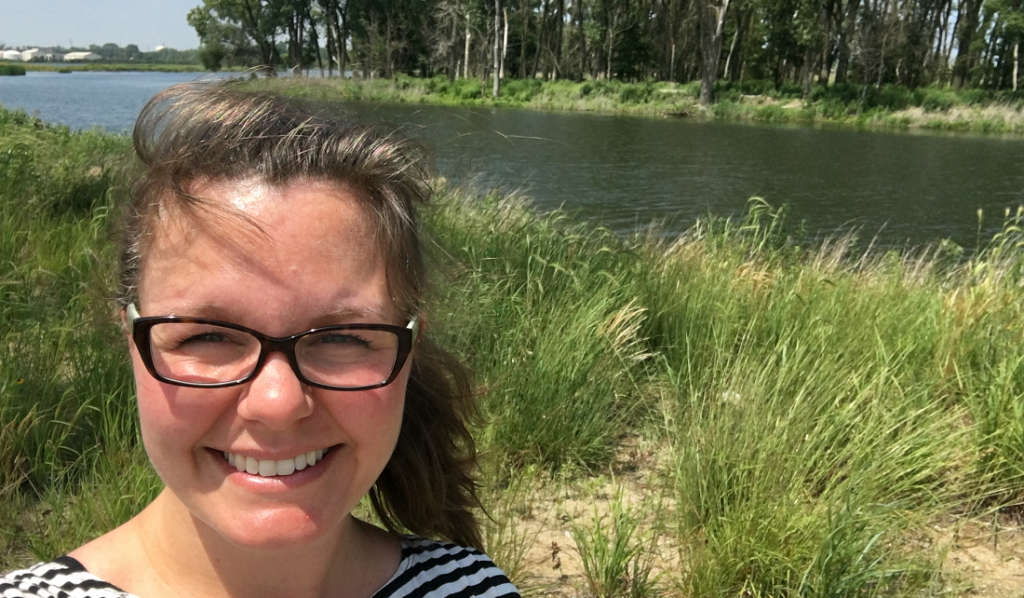
IISG’s Caitie Nigrelli stands in front of 58 acres of restored wetlands of the East Branch of the Grand Calumet River.
Leslie and I have worked many years on the Grand Calumet River remediation and restoration and led the workshop. IISG assistant, Ben Wegleitner, played a coordinating role. Working together, we brought in partners, Susan MiHalo (TNC), Carl Wodrich (DNR), and Anne Remek (IDEM), to talk about the Grand Calumet River and to host a tour of restored sites along the river.
As IISG education coordinator, Terri demonstrated curricula and classroom activities as educators worked in groups, insuring its infusion into existing science curricula.
She shared information about the issue of aquatic invasive species spread by sharing an innovative web site, Nab the Aquatic Invader! This engaging tool introduces students (grades 4-10) to marine and freshwater invasive species and their impacts using a detective theme and cartoon characters. Teachers also learned the environmental issue concerning improper release of classroom animals and plants and the threat they pose to the Great Lakes ecosystem through the campaigns, Habitattitude™ and Be a Hero-Transport Zero ™.

Carl Wodrich (right), Indiana Department of Natural Resources, guides educators on a hike.
Terri explained what she hoped to achieve that day—through direct experience with relevant education resources, these educators are now better equipped to explain how students can play an active role in helping to prevent the spread of AIS and foster a greater awareness of aquatic science.
For classroom activities and curriculum ideas, visit IISG’s Education Products page.
For information on the cleanup and restoration of the Grand Calumet River, visit www.greatlakesmud.org.
Terri Hallesy and Leslie Dorworth also contributed to this article.
Illinois-Indiana Sea Grant is a part of University of Illinois Extension and Purdue University Extension.
July 25th, 2017 by iisg_superadmin
While Illinois sits along one of the world’s largest freshwater resources, an ocean is closer than you might think. Look down. About 540 million years ago, the state was situated at the equator and was the site of an ancient sea. As land shifted over time, this saltwater became trapped in aquifers that still exist underground today.
Illinois-Indiana Sea Grant-funded researchers, thinking outside the box, wondered if this buried saltwater might play a role in producing seafood in the region. Their study revealed that Illinois may in fact, be an environmentally-sustainable and economically-viable location for production of marine fish. They focused on striped bass, a popular and adaptable fish that can be grown in a range of salinities.
Currently, the U.S. imports 86 percent of its seafood leading to a $10 billion trade deficit. “It is not surprising that interest in commercial aquaculture production in the marine environment has increased,” said Srirupa Ganguly, an engineer from the Illinois Sustainable Technology Center (ISTC). She was joined in this project by Nandakishore Rajagopalan, also at ISTC, and Kwamena Quagrainie, IISG’s aquaculture marketing specialist, located at Purdue University.
The team assessed the competitive advantages of raising this fish in the Midwest using local saline water resources. These sources include saline aquifers, with much of this water brought to the surface regularly in oil and gas drilling, but also water generated from coal processing and other industries.
“It’s clear that Illinois has considerable quantities of saline water available to support the needs of a marine aquaculture industry,” said Rajagopalan. “The cost of obtaining these waters will depend on accessibility.”
Depending on the source of the saline water, it may come with additional contaminants and need treatment for use in aquaculture. But, does this water provide a suitable environment for raising striped bass? The researchers measured growth, weight gain, and other characteristics of striped bass grown in pre-treated saline aquifer water.
“Our preliminary study revealed that fish farmers could substitute potable surface water for saline groundwater for the culture of saltwater species like striped bass,” said Ganguly.
Finally, to assess the viability question from all sides, the researchers looked at what motivates consumers as they shop for seafood and their willingness to pay more for locally-raised fish.
“Our survey found that when it comes to decisions about purchasing seafood, freshness is key, so consumer are willing to pay $6.00 or more per pound for striped bass produced in the Midwest,” said Quagrainie. “There is also considerable interest in the culture of shrimp, and other marine species that are more profitable in the marketplace.”
You can read Quagrainie’s article on consumers’ willingness to pay for saline fish species raised in the Midwest in World Aquaculture Society.
Illinois-Indiana Sea Grant is a part of University of Illinois Extension and Purdue University Extension.
June 21st, 2017 by iisg_superadmin
This story appears in Lake Michigan nearshore food web: Charting new waters, a new publication created by Illinois-Indiana Sea Grant and Wisconsin Sea Grant.
The Lake Michigan food web is in transition—not just in the question of who’s eating whom, but where fish and other organisms are finding food. In recent years, the nearshore has become the go-to location.
Ben Turschak and Harvey Bootsma, biologists at the University of Wisconsin-Milwaukee, set out to characterize the food web in Lake Michigan by capturing the dynamics of what’s happening in the waters near Milwaukee. They use carbon and nitrogen stable isotopes from fish tissue to learn what they are eating, and to understand where each species fits in the food web.
“Carbon stable isotope ratios tell us what a species eats or its primary energy source,” said Turschak. “Predators have a similar carbon isotope ratio to their prey. For instance, a fish that eats zooplankton might have a very different carbon isotope ratio than one that eats bottom-dwelling insects. By contrast, nitrogen stable isotopes become heavier as they go from a prey source to a predator, so they can reveal where a species is positioned in the food chain.”
The Milwaukee shoreline is characterized by a mixed sand and boulder bottom, with frequent cool water upwellings caused by wind pushing warm surface water towards Michigan. The researchers found the food web there could generally be separated into species that eat phytoplankton or those that dine on algae on the lake bottom in shallower nearshore areas. Generally, however, most fish species have begun to rely more heavily on nearshore energy sources.
The likely culprits in shifting the balance of productivity to the nearshore waters are invasive species. In particular, quagga mussels filter large quantities of water to feed on phytoplankton, this process clears the water and, in shallower nearshore areas, allows more light to reach the bottom. The mussels also excrete nutrient-rich waste that fertilizes the lake bottom. With more light and nutrients, bottom-growing algae can proliferate and support more bottom-dwelling invertebrates and the fish that feed on them.
“On the other hand, in offshore waters, mussels also filter phytoplankton and make the water clearer, but the increased water depth prevents enough light from reaching the bottom to support much algae. As a result, quagga mussels are leaving the deep offshore waters depleted relative to nearshore waters,” said Turschak.
“Decreases in offshore energy sources and increases in nearshore energy sources likely account for the fact that fish appear to be feeding more on nearshore energy sources,” explained Turschak.
The researchers also observed that typical patterns of diet change that occur as fish get larger have also shifted for some species. “This indicates that some fish species may have greater reliance on nearshore energy at particular stages of their life because of these food web changes,” said Turschak.
Illinois-Indiana Sea Grant is a part of University of Illinois Extension and Purdue University Extension.
June 21st, 2017 by iisg_superadmin
This story appears in Lake Michigan nearshore food web: Charting new waters, a new publication created by Illinois-Indiana Sea Grant and Wisconsin Sea Grant.
Round gobies have become big players in the Lake Michigan food web. A small but invasive fish, their success may be due to being masters of survival. More specifically, they make themselves at home in a variety of conditions with a variety of food options, settle in for the long haul, and protect their territory.
IISG Assistant Research Coordinator Carolyn Foley took part in a study to learn more about the round goby’s place in the food web. The research team sampled three sizes of gobies from many locations and in multiple seasons. They analyzed the goby diets using three techniques—stomach contents to learn what the fish are eating when caught, fatty acid signatures, which reveal what they have been consuming over several weeks, and stable isotopes, providing a picture of an even longer time frame.
They found location was the driving factor in terms of what the gobies ate and the fish tended to stay put over time. “It’s striking how they tend to stay in the same spot,” said Foley. “This makes sense for them because they are very territorial—they aggressively defend their home turf.”
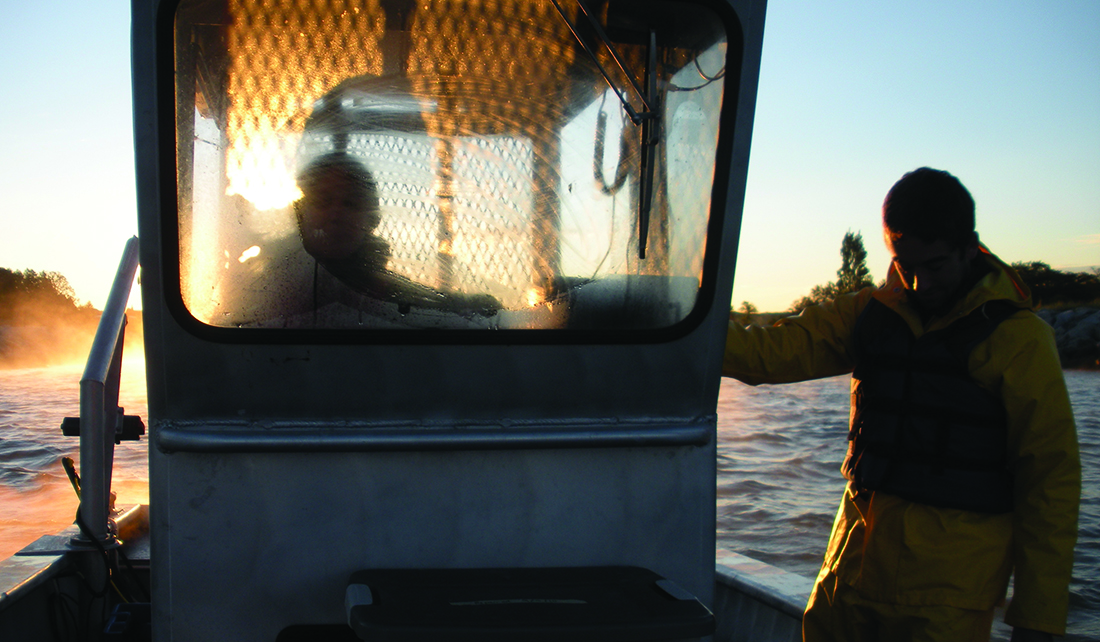
University of Illinois graduate student Austin Happel and Carolyn Foley, Illinois-Indiana Sea Grant assistant research coodinator, head out to collect fish and invertebrate samples in the waters near Manistee County. Photo by Sarah Stein
Gobies are known to prefer hard, rocky areas and to eat zebra mussels, but the reality may be more complicated. “We caught more gobies over hard substrate, which makes sense, but we found them over soft substrate too,” said Foley. “And since the diet analysis—stomach contents, fatty acids, and isotopes—are conveying the same information no matter what the timescale, we think it means they are taking advantage of whatever food sources are nearby.”
That gobies have become major players in Lake Michigan and that they are survivors may have the potential of providing some stability to the food web. “Their adaptability suggests that they will likely persist for a long time,” said Foley. “And as part of the food web, they too are being eaten—smallmouth bass and birds are eating gobies and are growing.”
But this brings up a concern. As bottom dwellers, round gobies hang out where the contaminants are. As these fish become entrenched in the food web, scientists wonder whether contaminants are more likely to move up through the food web to birds, top predator fish, and eventually, people.
Illinois-Indiana Sea Grant is a part of University of Illinois Extension and Purdue University Extension.
June 2nd, 2017 by iisg_superadmin
This story appears in Lake Michigan nearshore food web: Charting new waters, a new publication created by Illinois-Indiana Sea Grant and Wisconsin Sea Grant.
While the influx of invasive species has taken a toll on the Lake Michigan food web, the loss of habitats like coastal wetlands may be having impacts too. Researchers who are looking at how coastal wetlands contribute to lake habitats have, thus far, documented that various fish species like yellow perch and smallmouth bass use these wetlands at various points in their lives.
Biologists Gary Lamberti, University of Notre Dame, and Patrick Forsythe, University of Wisconsin-Green Bay, are leading a team whose goal is to quantify the role of coastal wetlands in sustaining sportfish. The project is in progress, but is making promising steps forward.
They are building the food web in wetland and nearshore habitats at nine paired wetland-nearshore sites around Lake Michigan, with the wetlands representing a variety of landscapes and distances from the lake. The scientists are using three measures from 50 species of fish, both prey and predators, to map out the story. The first two measures are commonly used—carbon and nitrogen stable isotopes. Carbon isotopes reveal location in terms of food source. It reveals what the base of the food web looks like.
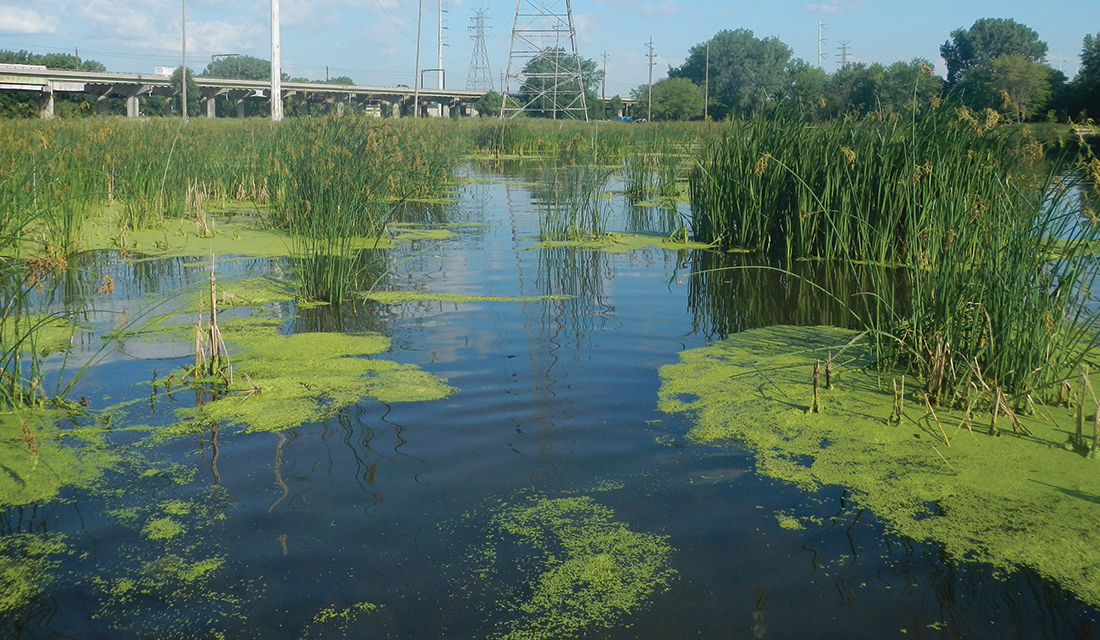
The newly restored Roxana Marsh in Indiana provides a study site for assessing the importance of wetlands to Lake Michigan sportfish.
“In a wetland, carbon cycling happens faster than in nearshore waters so the carbon signature is more depleted and that gets propagated up the food chain,” said Katherine O’Reilly, who has taken on this work as part of her doctorate at Notre Dame.
The nitrogen isotope indicates where a species sits in the food chain and can reveal what species are more predatory and are eating other fish versus those that are primary consumers, eating solely invertebrates or zooplankton.
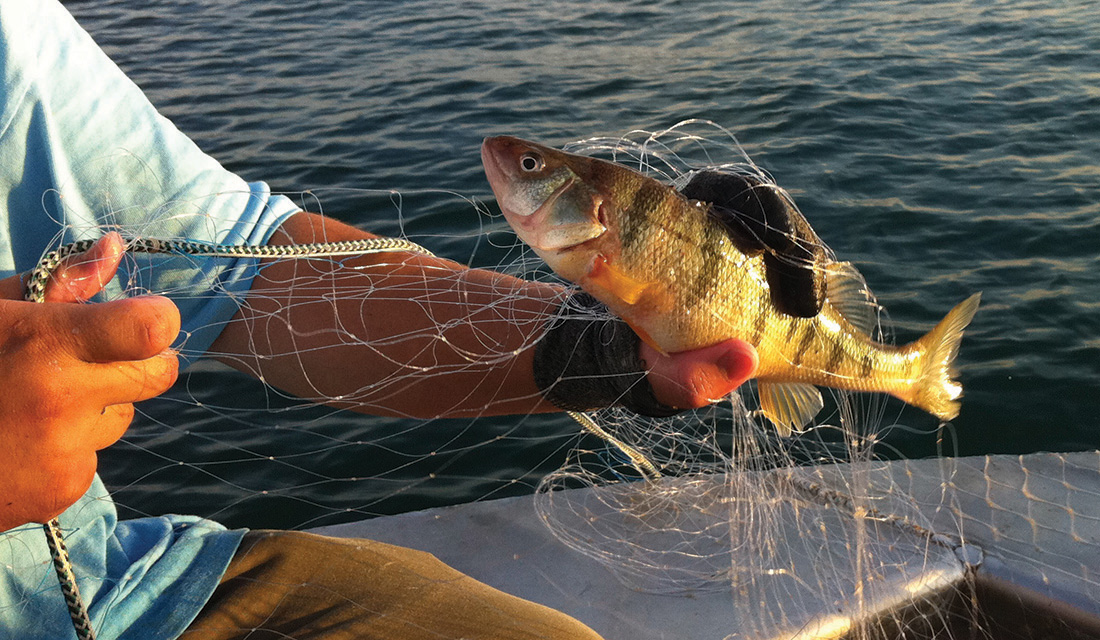
Nearshore areas, including wetlands, may play important roles to yellow perch and other sportfish.
The third measure is a technique first pioneered in marine studies. The researchers are analyzing trace element chemistry of otoliths, which are fish ear bones. Since they are always growing, otoliths provide a timeline of where the fish have been.
“The otolith is comprised of trace elements in the water and we’ve learned that water samples from wetlands and the nearshore are very different,” said O’Reilly. “We have found in the otolith that the fish are using wetlands at different times in their life cycles. This preliminary look at the microchemistry reveals that important sportfish like yellow perch and walleye are not staying in one habitat,” said O’Reilly. “They are moving energy between wetland and nearshore waters.”
As analysis progresses further, the researchers will be able to understand more about the connection between the two habitats. Ultimately, they are hoping to demonstrate the value of wetlands to the lake food web and sportfish.
“The question might need to be answered: How much is a wetland worth to a fishery?” said O’Reilly.
Illinois-Indiana Sea Grant is a part of University of Illinois Extension and Purdue University Extension.














